
PY 131 Chapter 23: Electric Current
Electric Current
The flow of electric charge from one place to another is called an electric current.
current = charge moved / time interval
In order to get a charge to flow there has to be:
a force which implies an electric field or,
a potential energy difference which implies a potential difference
The direction of the current is the flow of the positive charges
even though most currents are the flow of the electrons which are negative – historical accident.
current sounds like it should be a vector but it is not.
The SI unit of current is the ampere and the symbol is A.
For a given current through a material with known properties, we can find the speed of the charges.
This speed is called the drift velocity.
For a 1 A current in a copper wire with a diameter of 2 mm we find the drift velocity is ~10^-5 m/s.
it would take an electron hours to travel 1 meter along the wire.
The electrons in a material are not actually stationary, at room temperature they have speeds which are ~1000 km/s.
The speed of electrons due to their thermal motion is still slower than the speed of electricity along a wire.
the speed of electricity down a wire is ~150,000 – 300,000 km/s
The speed of electricity is the speed of the electric field.
Voltage Sources
A current flows from one place to another as long as there is a potential difference between those two places.
The other name for a potential is voltage.
There are many ways a creating the potential difference:
charged capacitors,
batteries (fuel cells),
Van der Graaff generators,
generators (dynamos and alternators)
Voltage sources are not sources of charge (they don’t store electrons), voltage sources are sources of energy
Batteries
Some chemical reactions involve the transfer of electrons from one atom to another. For example:
if you insert a zinc rod into a solution of copper sulfate, the zinc rod will dissolve into the solution and copper metal will plate the rod.
the solution contains Cu2+ ions which are missing two electrons: the zinc atoms in the rod are neutral.
in the reaction, two electrons are moved from the zinc to the copper.
now charged, the zinc dissolves in the solution and the neutral copper coats the rod.
A battery generates a voltage drop across its terminals by tapping into the electron flow in such chemical reactions.
another name for a battery is an electrochemical cell.
To prevent plating we use two half cells and connect them with a salt bridge. The two metals are often called electrodes.
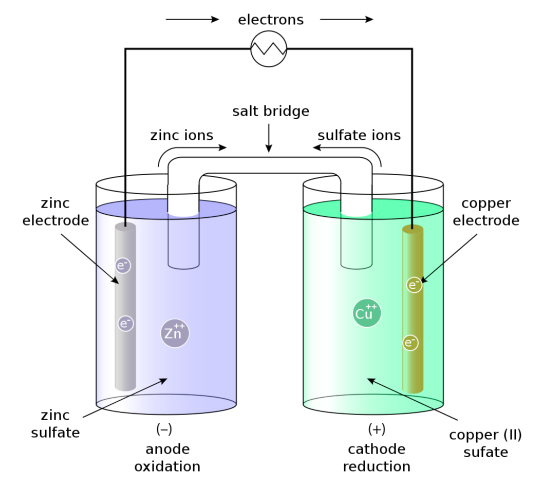
Modern batteries and fuel cells are still based on the principle of tapping into the electron flow in chemical reactions.
EXAMPLE 1:
Is electric current stored in a battery?
No. Voltage (potential energy), not current, is stored in batteries. The voltage will produce a current in a connecting circuit. The battery moves electrons already in the wire.
Resistance
Given a potential difference (voltage drop), the amount of current depends upon the resistance between the two points.
The higher the resistance, the smaller the current for a given voltage drop.
The resistance is defined to be
resistance= voltage drop / current
The unit of resistance is the ohm
the inverse of resistance is conductance which is measured in Siemens.
The resistance is a constant for many materials as a function of the current and voltage.
if it’s not the resistance is sometimes called static resistance.
Such materials are called Ohmic.
For such materials, the previous equation is rearranged to give
voltage drop=current×resistance
which is known as Ohm’s Law
The three factors which influence the resistance are:
the physical dimensions of the material
the material the current flows through,
the temperature.
The resistance:
increases with the length of the material the current flows through
decreases with the cross sectional area.
For resistors with the same physical dimensions and at typical temperatures, conductors have lower resistance than insulators.
For most conductors, resistance increases with temperature,
For semiconductors, the resistance decreases with temperature,
For insulators, their resistance may do either.
At very low temperatures some materials called superconductors have zero resistance
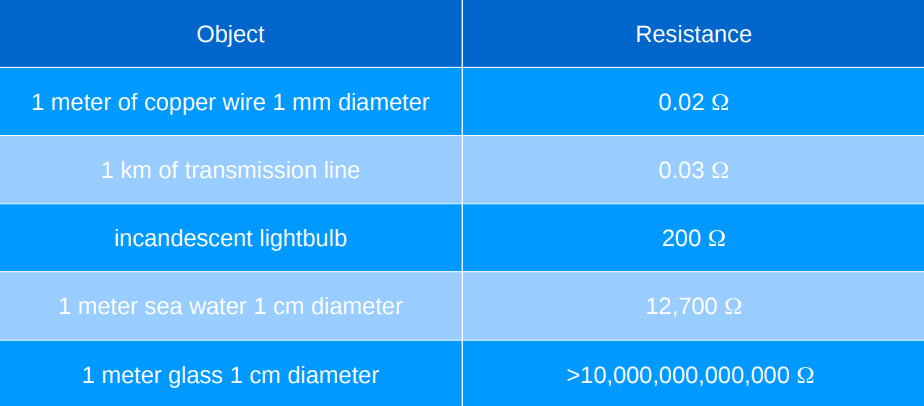
These are the resistances at low voltages.
At sufficiently high voltage across small distances, all materials (even empty space) become good conductors.
The voltage at which this occurs is called the breakdown voltage.
For air the breakdown voltage is 3 MV/m, for glass ~10 MV/m, for diamond it is 2000 MV/m, and for a vacuum 1012 MV/m.
Electric Safety
It is not voltage that is dangerous, it is current.
Remember voltage is related to potential energy. A high voltage is similar to standing on top of a mountain.
A current of 0.01 A is very painful, and 0.1 A can be fatal.
Household outlets have a potential of 120 V.
For a given voltage drop, the current increases as the resistance decreases.
The typical resistance of the human body is ~100,000 ohms but just ~100 ohms when it is wet. If the current flowing through an appliance finds it easier to reach ground through your body the current through you will be ~0.001 A if your skin is dry but ~1 A if it is wet.
Electricity and water are a very bad mixture
EXAMPLE 1:
What is the current through a 10 ohm resister connected to a 120 V power supply?
V = IR > I = V/R > I = 120 V / 10 ohms
I = 12 amps
AC/DC
When the voltage difference between two points is fixed the current always flows in the same direction.
A current that always flows in the same direction is called a direct current which is abbreviated as dc. There are some voltage sources where the voltage difference between two points alternates from negative to positive.
Here in the US, the voltage switches 60 times a second i.e. 60 Hz.
The constant switching of the potential difference causes the current to also switch directions. Such currents are called an alternating current which is abbreviated to ac.
in addition to their regular dc resistance, materials have a different kind of resistance to ac known as a reactance that doesn’t heat the material.
Reactance changes with the frequency of the alternations.

Electric Power
When a current flows, electrical potential energy of a charge is being converted into kinetic energy of the charge.
The kinetic energy of electric charges is what is usually called electrical energy.
Some of the kinetic energy is converted into heat due to resistance along the path of the current.
this kind of heating is called Joule heating or Ohmic heating.
Ohmic heating is proportional to the square of the current.
Power Lost=(Current) ^ 2×Resistance
What isn’t lost to heat can be used to do something useful.
The rate at which the electrical potential energy is converted into other forms of energy is the electrical power.
Power= Potential energy / time interval
Remember:
Potential energy=Charge×Voltage
Current= Charge moved / time interval
Putting these together we find
Power=Current×Voltage
As before, the unit of power is the watt, symbol W
Electric Circuits
An electric circuit is a voltage source plus one or more circuit elements continuously connected so as to allow a current to flow between the voltage source terminals. Circuit elements are various devices such as:
wires
switches,
capacitors,
resistors,
diodes
There is a lot of similarity between electric circuits and hydraulic circuits.
Each circuit element is represented by a symbol in a circuit diagram – a schematic diagram of the circuit.
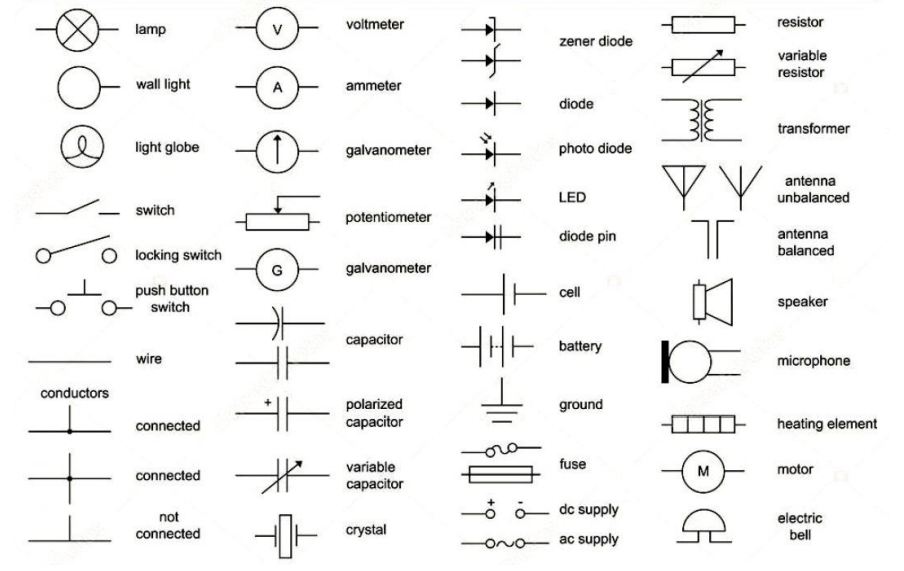
Switches and Fuses
A (direct) current only flows if there is a continuous path for the charge to flow between the terminals of the voltage source.
A switch is a simple device to create gaps in a circuit.
Current flows when the switch is closed, when it is open no current flows.
A fuse is a thin piece of wire that melts when the current through it becomes too large.
fuses create gaps in the path of the current when they blow.
fuses are rated by the amount of current flowing before they blow.
Larger than expected currents occur when the resistance of a device drops (typically because the device short circuits).
A fuse needs to be replaced when the wire blow: circuit breakers are similar to fuses but can be reset when tripped.
Diodes
Many electrical devices do not work with ac, they need dc.
your computer is one example.
Converting ac to dc is called rectification.
Diodes are circuit elements that only allow current to flow in one particular direction.
light-emitting diodes (LEDs) are special diodes that emit light.
Modern diodes are made from semiconductor materials such as silicon, sometimes germanium
diodes were the first semiconductor devices
A single diode will remove half the current.

Arrangements of several diodes called bridge rectifiers reverse the current without removing any of it
capacitors are included in the design to smooth the current
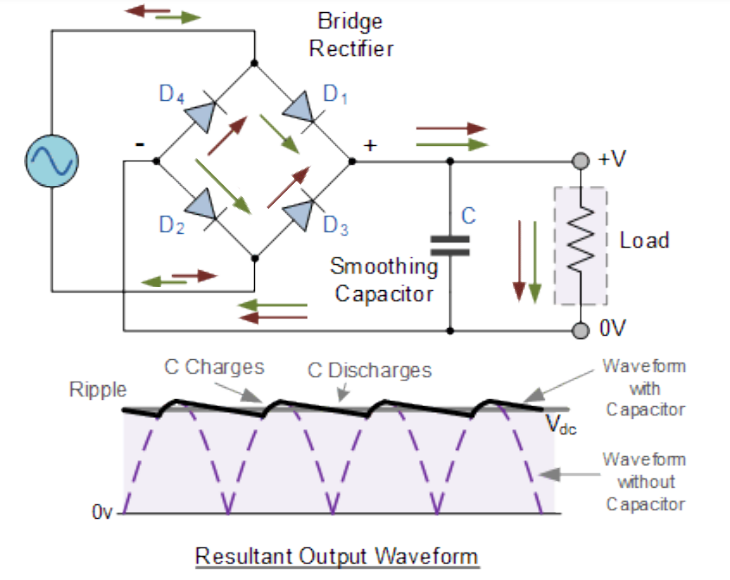
Series and Parallel Circuits
Circuits come in two basic designs: series and parallel.
A series circuit is one where the current has only one path between the terminals of the voltage source.
A parallel circuit is one where the current has two or more paths between the terminals of the voltage source.
A series circuit would be a battery, a switch and three lights such that the current has to flow through all the bulbs.
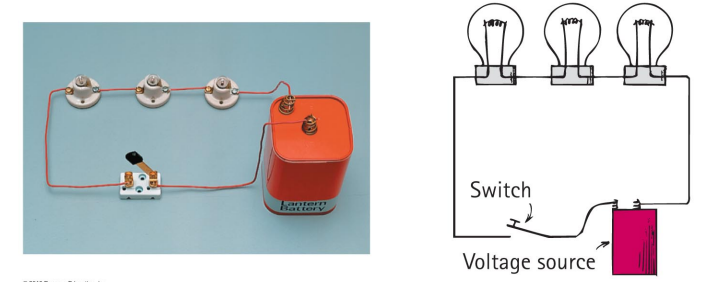
If there is a gap anywhere in the circuit, no current flows.
The current is determined by the total resistance.
The resistance of the circuit is the sum of the resistances of each circuit element.
There is a voltage drop across each element and the sum of each voltage drop equals the voltage source.
A parallel circuit would be a battery and three lightbulbs such that the current divides and can flow through only one bulb.
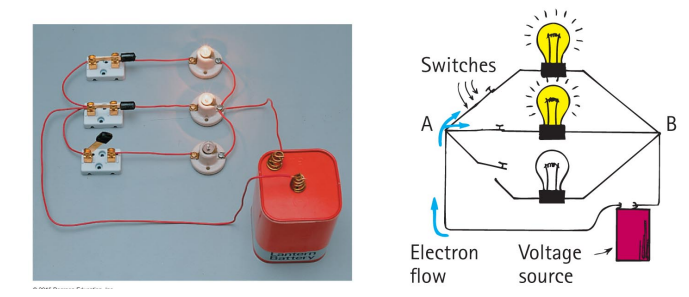
If there is a gap in one of the paths, current still flows.
The voltage drop across each element is the same for each.
The current splits to go through each branch with the current in a particular branch inversely proportional to the resistance through that branch.
The resistance of the circuit is less than the resistance of each circuit element (so less than the smallest).
EXAMPLE 1:
How does the resistance of a circuit change when two identical lamps in a circuit are connected in parallel?
It decreases.
Circuit branches in parallel are like extra lines at a checkout: more lines means less resistance, allowing for more flow.
PY 131 Chapter 23: Electric Current
Electric Current
The flow of electric charge from one place to another is called an electric current.
current = charge moved / time interval
In order to get a charge to flow there has to be:
a force which implies an electric field or,
a potential energy difference which implies a potential difference
The direction of the current is the flow of the positive charges
even though most currents are the flow of the electrons which are negative – historical accident.
current sounds like it should be a vector but it is not.
The SI unit of current is the ampere and the symbol is A.
For a given current through a material with known properties, we can find the speed of the charges.
This speed is called the drift velocity.
For a 1 A current in a copper wire with a diameter of 2 mm we find the drift velocity is ~10^-5 m/s.
it would take an electron hours to travel 1 meter along the wire.
The electrons in a material are not actually stationary, at room temperature they have speeds which are ~1000 km/s.
The speed of electrons due to their thermal motion is still slower than the speed of electricity along a wire.
the speed of electricity down a wire is ~150,000 – 300,000 km/s
The speed of electricity is the speed of the electric field.
Voltage Sources
A current flows from one place to another as long as there is a potential difference between those two places.
The other name for a potential is voltage.
There are many ways a creating the potential difference:
charged capacitors,
batteries (fuel cells),
Van der Graaff generators,
generators (dynamos and alternators)
Voltage sources are not sources of charge (they don’t store electrons), voltage sources are sources of energy
Batteries
Some chemical reactions involve the transfer of electrons from one atom to another. For example:
if you insert a zinc rod into a solution of copper sulfate, the zinc rod will dissolve into the solution and copper metal will plate the rod.
the solution contains Cu2+ ions which are missing two electrons: the zinc atoms in the rod are neutral.
in the reaction, two electrons are moved from the zinc to the copper.
now charged, the zinc dissolves in the solution and the neutral copper coats the rod.
A battery generates a voltage drop across its terminals by tapping into the electron flow in such chemical reactions.
another name for a battery is an electrochemical cell.
To prevent plating we use two half cells and connect them with a salt bridge. The two metals are often called electrodes.

Modern batteries and fuel cells are still based on the principle of tapping into the electron flow in chemical reactions.
EXAMPLE 1:
Is electric current stored in a battery?
No. Voltage (potential energy), not current, is stored in batteries. The voltage will produce a current in a connecting circuit. The battery moves electrons already in the wire.
Resistance
Given a potential difference (voltage drop), the amount of current depends upon the resistance between the two points.
The higher the resistance, the smaller the current for a given voltage drop.
The resistance is defined to be
resistance= voltage drop / current
The unit of resistance is the ohm
the inverse of resistance is conductance which is measured in Siemens.
The resistance is a constant for many materials as a function of the current and voltage.
if it’s not the resistance is sometimes called static resistance.
Such materials are called Ohmic.
For such materials, the previous equation is rearranged to give
voltage drop=current×resistance
which is known as Ohm’s Law
The three factors which influence the resistance are:
the physical dimensions of the material
the material the current flows through,
the temperature.
The resistance:
increases with the length of the material the current flows through
decreases with the cross sectional area.
For resistors with the same physical dimensions and at typical temperatures, conductors have lower resistance than insulators.
For most conductors, resistance increases with temperature,
For semiconductors, the resistance decreases with temperature,
For insulators, their resistance may do either.
At very low temperatures some materials called superconductors have zero resistance

These are the resistances at low voltages.
At sufficiently high voltage across small distances, all materials (even empty space) become good conductors.
The voltage at which this occurs is called the breakdown voltage.
For air the breakdown voltage is 3 MV/m, for glass ~10 MV/m, for diamond it is 2000 MV/m, and for a vacuum 1012 MV/m.
Electric Safety
It is not voltage that is dangerous, it is current.
Remember voltage is related to potential energy. A high voltage is similar to standing on top of a mountain.
A current of 0.01 A is very painful, and 0.1 A can be fatal.
Household outlets have a potential of 120 V.
For a given voltage drop, the current increases as the resistance decreases.
The typical resistance of the human body is ~100,000 ohms but just ~100 ohms when it is wet. If the current flowing through an appliance finds it easier to reach ground through your body the current through you will be ~0.001 A if your skin is dry but ~1 A if it is wet.
Electricity and water are a very bad mixture
EXAMPLE 1:
What is the current through a 10 ohm resister connected to a 120 V power supply?
V = IR > I = V/R > I = 120 V / 10 ohms
I = 12 amps
AC/DC
When the voltage difference between two points is fixed the current always flows in the same direction.
A current that always flows in the same direction is called a direct current which is abbreviated as dc. There are some voltage sources where the voltage difference between two points alternates from negative to positive.
Here in the US, the voltage switches 60 times a second i.e. 60 Hz.
The constant switching of the potential difference causes the current to also switch directions. Such currents are called an alternating current which is abbreviated to ac.
in addition to their regular dc resistance, materials have a different kind of resistance to ac known as a reactance that doesn’t heat the material.
Reactance changes with the frequency of the alternations.

Electric Power
When a current flows, electrical potential energy of a charge is being converted into kinetic energy of the charge.
The kinetic energy of electric charges is what is usually called electrical energy.
Some of the kinetic energy is converted into heat due to resistance along the path of the current.
this kind of heating is called Joule heating or Ohmic heating.
Ohmic heating is proportional to the square of the current.
Power Lost=(Current) ^ 2×Resistance
What isn’t lost to heat can be used to do something useful.
The rate at which the electrical potential energy is converted into other forms of energy is the electrical power.
Power= Potential energy / time interval
Remember:
Potential energy=Charge×Voltage
Current= Charge moved / time interval
Putting these together we find
Power=Current×Voltage
As before, the unit of power is the watt, symbol W
Electric Circuits
An electric circuit is a voltage source plus one or more circuit elements continuously connected so as to allow a current to flow between the voltage source terminals. Circuit elements are various devices such as:
wires
switches,
capacitors,
resistors,
diodes
There is a lot of similarity between electric circuits and hydraulic circuits.
Each circuit element is represented by a symbol in a circuit diagram – a schematic diagram of the circuit.

Switches and Fuses
A (direct) current only flows if there is a continuous path for the charge to flow between the terminals of the voltage source.
A switch is a simple device to create gaps in a circuit.
Current flows when the switch is closed, when it is open no current flows.
A fuse is a thin piece of wire that melts when the current through it becomes too large.
fuses create gaps in the path of the current when they blow.
fuses are rated by the amount of current flowing before they blow.
Larger than expected currents occur when the resistance of a device drops (typically because the device short circuits).
A fuse needs to be replaced when the wire blow: circuit breakers are similar to fuses but can be reset when tripped.
Diodes
Many electrical devices do not work with ac, they need dc.
your computer is one example.
Converting ac to dc is called rectification.
Diodes are circuit elements that only allow current to flow in one particular direction.
light-emitting diodes (LEDs) are special diodes that emit light.
Modern diodes are made from semiconductor materials such as silicon, sometimes germanium
diodes were the first semiconductor devices
A single diode will remove half the current.

Arrangements of several diodes called bridge rectifiers reverse the current without removing any of it
capacitors are included in the design to smooth the current

Series and Parallel Circuits
Circuits come in two basic designs: series and parallel.
A series circuit is one where the current has only one path between the terminals of the voltage source.
A parallel circuit is one where the current has two or more paths between the terminals of the voltage source.
A series circuit would be a battery, a switch and three lights such that the current has to flow through all the bulbs.

If there is a gap anywhere in the circuit, no current flows.
The current is determined by the total resistance.
The resistance of the circuit is the sum of the resistances of each circuit element.
There is a voltage drop across each element and the sum of each voltage drop equals the voltage source.
A parallel circuit would be a battery and three lightbulbs such that the current divides and can flow through only one bulb.

If there is a gap in one of the paths, current still flows.
The voltage drop across each element is the same for each.
The current splits to go through each branch with the current in a particular branch inversely proportional to the resistance through that branch.
The resistance of the circuit is less than the resistance of each circuit element (so less than the smallest).
EXAMPLE 1:
How does the resistance of a circuit change when two identical lamps in a circuit are connected in parallel?
It decreases.
Circuit branches in parallel are like extra lines at a checkout: more lines means less resistance, allowing for more flow.
 Knowt
Knowt
